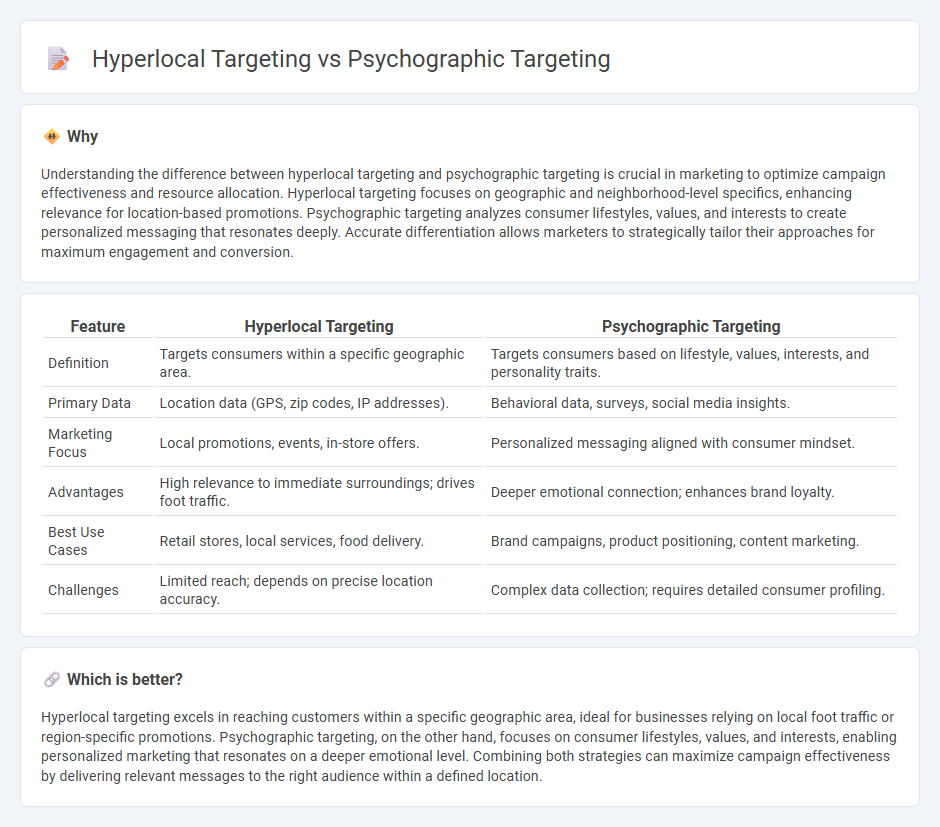
Hyperlocal targeting focuses on reaching consumers within a specific geographic area, leveraging location data to deliver highly relevant offers and promotions. Psychographic targeting goes deeper by analyzing consumers' lifestyles, interests, values, and personality traits to create more personalized marketing messages. Discover how leveraging these targeting strategies can optimize your marketing campaigns for better engagement and ROI.
Why it is important
Understanding the difference between hyperlocal targeting and psychographic targeting is crucial in marketing to optimize campaign effectiveness and resource allocation. Hyperlocal targeting focuses on geographic and neighborhood-level specifics, enhancing relevance for location-based promotions. Psychographic targeting analyzes consumer lifestyles, values, and interests to create personalized messaging that resonates deeply. Accurate differentiation allows marketers to strategically tailor their approaches for maximum engagement and conversion.
Comparison Table
| Feature | Hyperlocal Targeting | Psychographic Targeting |
|---|---|---|
| Definition | Targets consumers within a specific geographic area. | Targets consumers based on lifestyle, values, interests, and personality traits. |
| Primary Data | Location data (GPS, zip codes, IP addresses). | Behavioral data, surveys, social media insights. |
| Marketing Focus | Local promotions, events, in-store offers. | Personalized messaging aligned with consumer mindset. |
| Advantages | High relevance to immediate surroundings; drives foot traffic. | Deeper emotional connection; enhances brand loyalty. |
| Best Use Cases | Retail stores, local services, food delivery. | Brand campaigns, product positioning, content marketing. |
| Challenges | Limited reach; depends on precise location accuracy. | Complex data collection; requires detailed consumer profiling. |
Which is better?
Hyperlocal targeting excels in reaching customers within a specific geographic area, ideal for businesses relying on local foot traffic or region-specific promotions. Psychographic targeting, on the other hand, focuses on consumer lifestyles, values, and interests, enabling personalized marketing that resonates on a deeper emotional level. Combining both strategies can maximize campaign effectiveness by delivering relevant messages to the right audience within a defined location.
Connection
Hyperlocal targeting and psychographic targeting intersect by focusing on specific consumer attributes within a precise geographic area, enhancing relevance and engagement. By integrating hyperlocal data such as location, weather, and local events with psychographic insights like interests, values, and lifestyles, marketers create highly personalized campaigns that resonate deeply with targeted audiences. This connection boosts conversion rates, improves customer retention, and maximizes return on investment through tailored messaging at a granular level.
Key Terms
Psychographic Targeting:
Psychographic targeting focuses on audience segmentation based on psychological attributes such as values, interests, lifestyles, and personality traits, enabling marketers to deliver highly personalized content that resonates deeply with consumer motivations. This approach leverages data from social media behavior, surveys, and customer feedback to predict purchasing behavior and enhance engagement, outperforming traditional demographic targeting methods. Explore the benefits and strategies of psychographic targeting to maximize your marketing impact and drive customer loyalty.
Lifestyle segmentation
Psychographic targeting segments audiences based on lifestyle choices, values, interests, and personality traits, enabling personalized marketing messages that resonate on a deeper emotional level. Hyperlocal targeting zeroes in on specific geographic areas, allowing brands to deliver contextually relevant offers and promotions tailored to the local environment and community behaviors. Explore how combining lifestyle segmentation with precise geographic insights can elevate your marketing strategy for maximum engagement.
Attitudes and values
Psychographic targeting specifically focuses on consumers' attitudes, values, lifestyles, and personality traits to tailor marketing messages that resonate on a deeper emotional and psychological level. Hyperlocal targeting, meanwhile, zeroes in on geographic context, targeting audiences based on their immediate location rather than intrinsic behaviors or beliefs. Discover how combining psychographic insights with hyperlocal strategies can enhance campaign precision and effectiveness.
Source and External Links
Psychographic segmentation for ultra-targeted marketing - Psychographic targeting involves segmenting audiences based on personality, lifestyle, social status, attitudes, interests, and opinions, enabling marketers to create highly personalized and effective campaigns that resonate deeply with consumers' values and motivations.
Psychographics: Definition & Marketing Use Cases - Psychographic targeting goes beyond demographics by grouping individuals according to psychological traits like personality, values, and lifestyle, allowing brands to tailor messages to distinct consumer segments such as environmentally conscious shoppers or adventure seekers.
What is psychographic segmentation? Examples and best practices - Psychographic segmentation sorts consumers into groups based on psychological characteristics including personality, interests, attitudes, and social status, helping marketers develop buyer personas and create strategies that connect with customers on a deeper emotional level.
 dowidth.com
dowidth.com